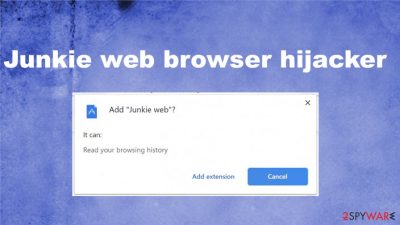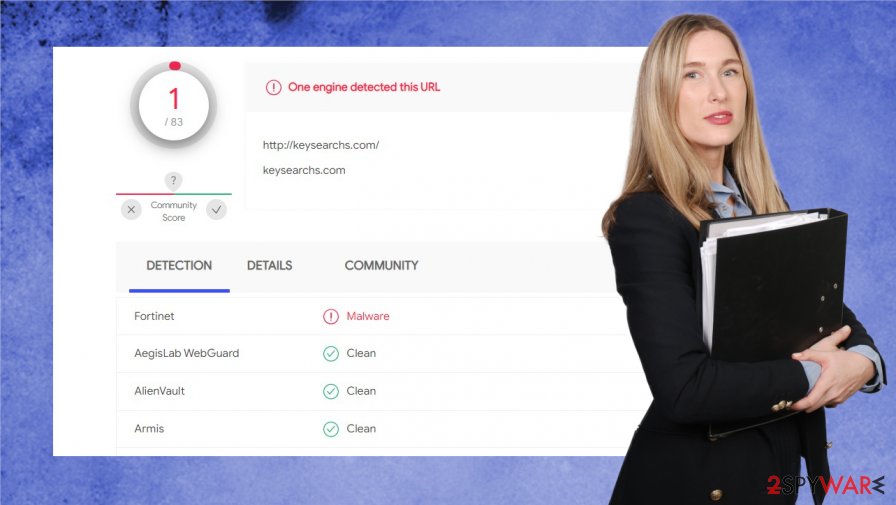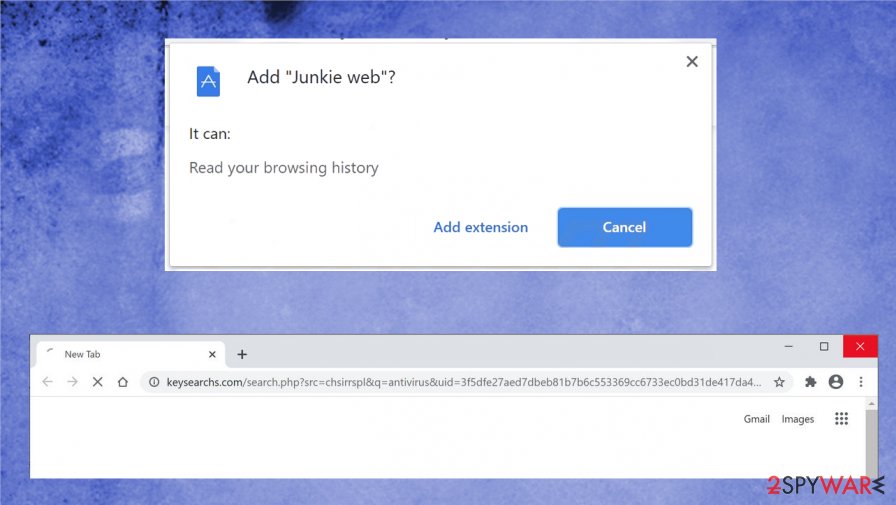Junkie web browser hijacker (Virus Removal Instructions) - Chrome, Firefox, IE, Edge
Junkie web browser hijacker Removal Guide
What is Junkie web browser hijacker?
Junkie web browser hijacker – a PUP that redirects all searches through a fake search engine

Junkie web is a browser hijacker because it might change browser settings, such as the homepage, new tab, default search engine. Once it's installed as a program or as a browser extension, every time users type something into the URL bar, their search inquires are redirected through keysearchs.com. All the results get injected with ads, banners, triggers redirects to suspicious or even dangerous commercial pages.
That's a fake search site as it doesn't generate any search results by itself. Depending on users' geolocations, they are redirected either to Google search or through my-search.com, then search-checker.com, until ending up on Bing search. By doing that, Junkie web browser hijacker is able to collect browsing-related data that might be shared with interested third-parties or advertising companies.
Because of information collection, redirects, and stealthy distribution techniques Junkie web virus is categorized as a potentially unwanted program (or PUP for short) and thus should not be used by anyone who values their safety and privacy. This article explains how it might have ended up on a device, how to remove it, and how to restore the system's general wellbeing.
| name | Junkie web |
|---|---|
| type | Potentially unwanted program, browser hijacker, |
| Browser changes | Startpage, new tab, default search engine. The extension gets installed |
| Ip address | 104.21.36.47 |
| promoted sites | Mainly – keysearchs.com. In some cases – my-search.com and search-checker.com |
| Symptoms | A slower internet connection and overall device performance. Redirects, continuous advertisements, additional installs |
| Risks | Gathered browsing data reveals browsing habits that might be shared with advertisers or other interested parties |
| Distribution | Freeware bundles, deceptive ads |
| removal | Trustworthy anti-malware software should be used to remove PUPs and any other suspicious apps |
| System Fix | Users need to take care of the overall health of their devices by using powerful system repair tools like the FortectIntego app |
Browser hijackers might be promoted to increase user's privacy while browsing the internet but rarely anyone download and install them willingly. Mostly these PUPs find their way into devices through deceptive ads or software/freeware bundles, i.e., packs of more than one application.
Junkie web browser hijacker and other PUPs don't provide any privacy. In fact, it might do the exact opposite by collecting various browsing-related data, which includes:
- IP addresses.
- Browser and device information.
- Geolocation.
- Most frequently visited sites.
- Search queries, etc.
Such data collection and different third-party involvement should encourage you to search for solutions to fight these redirects and unwanted advertisements. Make sure to clean the machine with proper tools and eliminate the PUP, but remember about the damage done to Google Chrome, Mozilla Firefox, MS Edge, Safari browsers. You can find a guide below for browser resetting.

If you've got this PUP installed on your device unwillingly or you're tired of its redirects or any other of its functions – it's time to remove Junkie web from your device. If you want to get rid of it automatically, then we recommend using reliable anti-malware software like SpyHunter 5Combo Cleaner or Malwarebytes for that.
Once Junkie web removal is finished, experts[1] advise performing a system tune-up. The best way to do that is by scanning your entire computer system with powerful system repair apps like the FortectIntego tool and letting the software do the rest.
Learn how to identify deceptive advertisements
Cybercriminals are using deceptive ads to trick people into downloading something that they have no need for. All kinds of malware and potentially unwanted programs[2] can be delivered through these apps. So our cybersecurity team compiled a few pointers to help users distinguish false ads and malicious browser extensions.
First of all, no legitimate website asks its visitors to download some application or install a browser extension to view some secret content. Only high-risk shady portals use these techniques to distribute PUPs that would display banners, pop-ups, and other kinds of unwanted ads.

And no website has the power to detect whether some software installed on users' devices needs to be updated or that a malware infection contaminates the computer itself. Cybercriminals use these tricks to deceive users into downloading and installing PUPs or hazardous malicious software.
Simple steps to remove Junkie web browser hijacker and restore the system settings
PUPs may not seem as dangerous as malware,[3] but they don't do any good either. Users are either tricked into installing them, or they get installed without direct consent. Thus there's no place for a browser hijacker on a machine. The best way to remove Junkie web is by using anti-malware tools that would complete this task automatically.
Some pieces might require users to do Junkie web removal manually. Please don't be frightened, as it doesn't require extensive knowledge. We provide free step-by-step instructions for that just below this paragraph. After all is said and done, don't forget to repair any system issues with powerful system tune-up tools to get your device back on track.
You may remove virus damage with a help of FortectIntego. SpyHunter 5Combo Cleaner and Malwarebytes are recommended to detect potentially unwanted programs and viruses with all their files and registry entries that are related to them.
Getting rid of Junkie web browser hijacker. Follow these steps
Uninstall from Windows
Run through the system and remove Junkie web hijack
Instructions for Windows 10/8 machines:
- Enter Control Panel into Windows search box and hit Enter or click on the search result.
- Under Programs, select Uninstall a program.

- From the list, find the entry of the suspicious program.
- Right-click on the application and select Uninstall.
- If User Account Control shows up, click Yes.
- Wait till uninstallation process is complete and click OK.

If you are Windows 7/XP user, proceed with the following instructions:
- Click on Windows Start > Control Panel located on the right pane (if you are Windows XP user, click on Add/Remove Programs).
- In Control Panel, select Programs > Uninstall a program.

- Pick the unwanted application by clicking on it once.
- At the top, click Uninstall/Change.
- In the confirmation prompt, pick Yes.
- Click OK once the removal process is finished.
Delete from macOS
Remove items from Applications folder:
- From the menu bar, select Go > Applications.
- In the Applications folder, look for all related entries.
- Click on the app and drag it to Trash (or right-click and pick Move to Trash)

To fully remove an unwanted app, you need to access Application Support, LaunchAgents, and LaunchDaemons folders and delete relevant files:
- Select Go > Go to Folder.
- Enter /Library/Application Support and click Go or press Enter.
- In the Application Support folder, look for any dubious entries and then delete them.
- Now enter /Library/LaunchAgents and /Library/LaunchDaemons folders the same way and terminate all the related .plist files.

Remove from Microsoft Edge
Delete unwanted extensions from MS Edge:
- Select Menu (three horizontal dots at the top-right of the browser window) and pick Extensions.
- From the list, pick the extension and click on the Gear icon.
- Click on Uninstall at the bottom.

Clear cookies and other browser data:
- Click on the Menu (three horizontal dots at the top-right of the browser window) and select Privacy & security.
- Under Clear browsing data, pick Choose what to clear.
- Select everything (apart from passwords, although you might want to include Media licenses as well, if applicable) and click on Clear.

Restore new tab and homepage settings:
- Click the menu icon and choose Settings.
- Then find On startup section.
- Click Disable if you found any suspicious domain.
Reset MS Edge if the above steps did not work:
- Press on Ctrl + Shift + Esc to open Task Manager.
- Click on More details arrow at the bottom of the window.
- Select Details tab.
- Now scroll down and locate every entry with Microsoft Edge name in it. Right-click on each of them and select End Task to stop MS Edge from running.

If this solution failed to help you, you need to use an advanced Edge reset method. Note that you need to backup your data before proceeding.
- Find the following folder on your computer: C:\\Users\\%username%\\AppData\\Local\\Packages\\Microsoft.MicrosoftEdge_8wekyb3d8bbwe.
- Press Ctrl + A on your keyboard to select all folders.
- Right-click on them and pick Delete

- Now right-click on the Start button and pick Windows PowerShell (Admin).
- When the new window opens, copy and paste the following command, and then press Enter:
Get-AppXPackage -AllUsers -Name Microsoft.MicrosoftEdge | Foreach {Add-AppxPackage -DisableDevelopmentMode -Register “$($_.InstallLocation)\\AppXManifest.xml” -Verbose

Instructions for Chromium-based Edge
Delete extensions from MS Edge (Chromium):
- Open Edge and click select Settings > Extensions.
- Delete unwanted extensions by clicking Remove.

Clear cache and site data:
- Click on Menu and go to Settings.
- Select Privacy, search and services.
- Under Clear browsing data, pick Choose what to clear.
- Under Time range, pick All time.
- Select Clear now.

Reset Chromium-based MS Edge:
- Click on Menu and select Settings.
- On the left side, pick Reset settings.
- Select Restore settings to their default values.
- Confirm with Reset.

Remove from Mozilla Firefox (FF)
Remove dangerous extensions:
- Open Mozilla Firefox browser and click on the Menu (three horizontal lines at the top-right of the window).
- Select Add-ons.
- In here, select unwanted plugin and click Remove.

Reset the homepage:
- Click three horizontal lines at the top right corner to open the menu.
- Choose Options.
- Under Home options, enter your preferred site that will open every time you newly open the Mozilla Firefox.
Clear cookies and site data:
- Click Menu and pick Settings.
- Go to Privacy & Security section.
- Scroll down to locate Cookies and Site Data.
- Click on Clear Data…
- Select Cookies and Site Data, as well as Cached Web Content and press Clear.

Reset Mozilla Firefox
If clearing the browser as explained above did not help, reset Mozilla Firefox:
- Open Mozilla Firefox browser and click the Menu.
- Go to Help and then choose Troubleshooting Information.

- Under Give Firefox a tune up section, click on Refresh Firefox…
- Once the pop-up shows up, confirm the action by pressing on Refresh Firefox.

Remove from Google Chrome
Reset Chrome to default and clear any suspicious applications off of it
Delete malicious extensions from Google Chrome:
- Open Google Chrome, click on the Menu (three vertical dots at the top-right corner) and select More tools > Extensions.
- In the newly opened window, you will see all the installed extensions. Uninstall all the suspicious plugins that might be related to the unwanted program by clicking Remove.

Clear cache and web data from Chrome:
- Click on Menu and pick Settings.
- Under Privacy and security, select Clear browsing data.
- Select Browsing history, Cookies and other site data, as well as Cached images and files.
- Click Clear data.

Change your homepage:
- Click menu and choose Settings.
- Look for a suspicious site in the On startup section.
- Click on Open a specific or set of pages and click on three dots to find the Remove option.
Reset Google Chrome:
If the previous methods did not help you, reset Google Chrome to eliminate all the unwanted components:
- Click on Menu and select Settings.
- In the Settings, scroll down and click Advanced.
- Scroll down and locate Reset and clean up section.
- Now click Restore settings to their original defaults.
- Confirm with Reset settings.

Delete from Safari
Remove unwanted extensions from Safari:
- Click Safari > Preferences…
- In the new window, pick Extensions.
- Select the unwanted extension and select Uninstall.

Clear cookies and other website data from Safari:
- Click Safari > Clear History…
- From the drop-down menu under Clear, pick all history.
- Confirm with Clear History.

Reset Safari if the above-mentioned steps did not help you:
- Click Safari > Preferences…
- Go to Advanced tab.
- Tick the Show Develop menu in menu bar.
- From the menu bar, click Develop, and then select Empty Caches.

After uninstalling this potentially unwanted program (PUP) and fixing each of your web browsers, we recommend you to scan your PC system with a reputable anti-spyware. This will help you to get rid of Junkie web browser hijacker registry traces and will also identify related parasites or possible malware infections on your computer. For that you can use our top-rated malware remover: FortectIntego, SpyHunter 5Combo Cleaner or Malwarebytes.
How to prevent from getting browser hijacker
Protect your privacy – employ a VPN
There are several ways how to make your online time more private – you can access an incognito tab. However, there is no secret that even in this mode, you are tracked for advertising purposes. There is a way to add an extra layer of protection and create a completely anonymous web browsing practice with the help of Private Internet Access VPN. This software reroutes traffic through different servers, thus leaving your IP address and geolocation in disguise. Besides, it is based on a strict no-log policy, meaning that no data will be recorded, leaked, and available for both first and third parties. The combination of a secure web browser and Private Internet Access VPN will let you browse the Internet without a feeling of being spied or targeted by criminals.
No backups? No problem. Use a data recovery tool
If you wonder how data loss can occur, you should not look any further for answers – human errors, malware attacks, hardware failures, power cuts, natural disasters, or even simple negligence. In some cases, lost files are extremely important, and many straight out panic when such an unfortunate course of events happen. Due to this, you should always ensure that you prepare proper data backups on a regular basis.
If you were caught by surprise and did not have any backups to restore your files from, not everything is lost. Data Recovery Pro is one of the leading file recovery solutions you can find on the market – it is likely to restore even lost emails or data located on an external device.
- ^ NoVirus. Novirus. Spyware and security news.
- ^ Potentially unwanted program. Wikipedia. The free encyclopedia.
- ^ Roger A. Grimes. 9 types of malware and how to recognize them. Cso. Security news, features and analysis.























